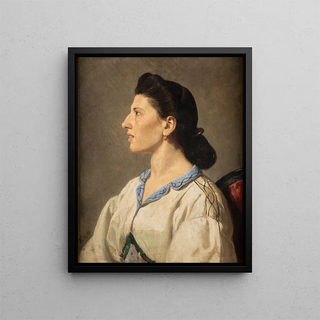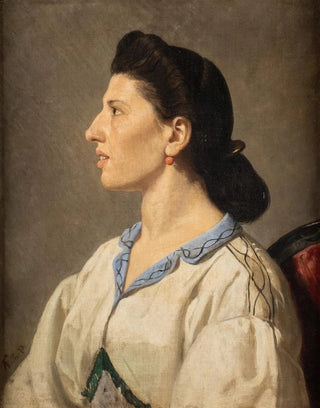Art print | Portrait of an Italian woman - Anselm Feuerbach


View from behind

Frame (optional)
Portrait of an Italian Woman - Anselm Feuerbach – Captivating Introduction
In the fascinating universe of art, some works stand out for their ability to capture the very essence of humanity. The "Portrait of an Italian Woman" by Anselm Feuerbach is one of those creations that transcend time and space. Created in the 19th century, this painting evokes timeless beauty, blending the delicacy of feminine features with the psychological depth of a mysterious figure. The woman's gaze, both gentle and piercing, invites the viewer to ponder her story, emotions, and inner world. This piece is much more than a simple representation; it is an open window into the human soul.
Style and uniqueness of the work
Feuerbach's style is characterized by a remarkable mastery of light and shadow, creating an intimate atmosphere that envelops the subject. In the "Portrait of an Italian Woman," the color nuances are carefully chosen, ranging from warm tones to cooler shades, bringing the model's skin to life while emphasizing the richness of her clothing. The texture of the fabrics is rendered with such precision that one could almost feel their touch. Additionally, the artist skillfully plays with composition, placing the woman slightly in profile, which adds dynamism to the work while maintaining a classic elegance. This portrait is not limited to a simple representation; it is a true exploration of femininity, where every detail contributes to strengthening the emotion conveyed by the painting.
The artist and his influence
Anselm Feuerbach, an emblematic figure of the Romantic movement, established himself as a major artist of his time. His training at the Munich Academy of Fine Arts and his travels in Italy profoundly influenced his work, allowing him to incorporate elements of the Renaissance into his creations. Feuerbach is often considered a bridge between classicism and modernism, and his approach to portraiture paved the way for many subsequent artists. By emphasizing individuality and the psychology of his subjects, he helped redefine portrait standards, transforming it into a means of personal and introspective expression. The "

Matte finish

View from behind

Frame (optional)
Portrait of an Italian Woman - Anselm Feuerbach – Captivating Introduction
In the fascinating universe of art, some works stand out for their ability to capture the very essence of humanity. The "Portrait of an Italian Woman" by Anselm Feuerbach is one of those creations that transcend time and space. Created in the 19th century, this painting evokes timeless beauty, blending the delicacy of feminine features with the psychological depth of a mysterious figure. The woman's gaze, both gentle and piercing, invites the viewer to ponder her story, emotions, and inner world. This piece is much more than a simple representation; it is an open window into the human soul.
Style and uniqueness of the work
Feuerbach's style is characterized by a remarkable mastery of light and shadow, creating an intimate atmosphere that envelops the subject. In the "Portrait of an Italian Woman," the color nuances are carefully chosen, ranging from warm tones to cooler shades, bringing the model's skin to life while emphasizing the richness of her clothing. The texture of the fabrics is rendered with such precision that one could almost feel their touch. Additionally, the artist skillfully plays with composition, placing the woman slightly in profile, which adds dynamism to the work while maintaining a classic elegance. This portrait is not limited to a simple representation; it is a true exploration of femininity, where every detail contributes to strengthening the emotion conveyed by the painting.
The artist and his influence
Anselm Feuerbach, an emblematic figure of the Romantic movement, established himself as a major artist of his time. His training at the Munich Academy of Fine Arts and his travels in Italy profoundly influenced his work, allowing him to incorporate elements of the Renaissance into his creations. Feuerbach is often considered a bridge between classicism and modernism, and his approach to portraiture paved the way for many subsequent artists. By emphasizing individuality and the psychology of his subjects, he helped redefine portrait standards, transforming it into a means of personal and introspective expression. The "






